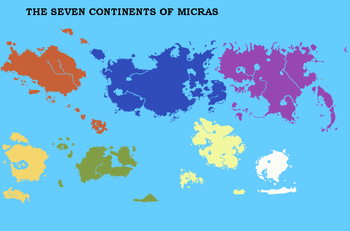Micras: Difference between revisions
NewZimiaGov (talk | contribs) No edit summary |
NewZimiaGov (talk | contribs) No edit summary |
||
| Line 29: | Line 29: | ||
|'''Surface Gravity (m/s^2)''' || 10.9 | |'''Surface Gravity (m/s^2)''' || 10.9 | ||
|- | |- | ||
|'''Axial | |'''Axial Tilt (degrees)''' || 22.5 | ||
|- | |- | ||
|'''Inclination (degrees)''' || 0 | |'''Inclination (degrees)''' || 0 | ||
| Line 35: | Line 35: | ||
|'''Orbital Speed (Km/s)''' || 34.8 | |'''Orbital Speed (Km/s)''' || 34.8 | ||
|- | |- | ||
|'''Land/Sea Ratio''' || 36.51%/63.49% | |'''Land/Sea Ratio''' || 36.51%/63.49% | ||
|- | |- | ||
|'''Satellites''' || [[Tarsica]] | |'''Satellites''' || [[Tarsica]] | ||
|- | |- | ||
| align=center colspan=2 style="background: #c0c0ff; text-align:center;"| '''Atmospheric Characteristics''' | | align=center colspan=2 style="background: #c0c0ff; text-align:center;"| '''Atmospheric Characteristics''' | ||
| Line 54: | Line 53: | ||
|'''Degrees of Freedom''' || 5 | |'''Degrees of Freedom''' || 5 | ||
|- | |- | ||
|'''Specific Heat Const Pressure (Cv)''' || | |'''Specific Heat Const Pressure (Cv)''' || 718 | ||
|- | |- | ||
|'''Lapse Rate Dry Adiabatic (K/m)''' || 0. | |'''Lapse Rate Dry Adiabatic (K/m)''' || 0.0098 | ||
|- | |- | ||
|'''Emissivity IR''' || 1 | |'''Emissivity IR''' || 1 | ||
| Line 62: | Line 61: | ||
|'''Visual Temperature (K)''' || 290 | |'''Visual Temperature (K)''' || 290 | ||
|- | |- | ||
|'''Effective Temperature (K)''' || | |'''Effective Temperature (K)''' || 255 | ||
|- | |- | ||
|'''Surface Pressure (lb/in2)''' || | |'''Surface Pressure (lb/in2)''' || 14.7 | ||
|- | |- | ||
|'''Co2PPMV''' || | |'''Co2PPMV''' || 400 | ||
|- | |- | ||
|'''Co2 Emissions (Metric Ton per Capita)''' || 1.916666667 | |'''Co2 Emissions (Metric Ton per Capita)''' || 1.916666667 | ||
| Line 83: | Line 82: | ||
|- | |- | ||
|*Information Relevant to Map Version 15.8.9 | |*Information Relevant to Map Version 15.8.9 | ||
|} | |} | ||
'''Micras''' is the official name of the [[micronational]] map that contains the fictional land holdings of many [[Anglophone Sector]] micronations. However there are a few exceptions with members from the [[Dutch Sector]] among other sectors on the map. The vast majority of micronational literature uses this map as the setting for their micronational fictional stories. | '''Micras''' is the official name of the [[micronational]] map that contains the fictional land holdings of many [[Anglophone Sector]] micronations. However there are a few exceptions with members from the [[Dutch Sector]] among other sectors on the map. The vast majority of micronational literature uses this map as the setting for their micronational fictional stories. | ||
Revision as of 22:59, 26 July 2024
| ||
| Orbital characteristics | ||
| Mass (Kg) | 7.74E+24 | |
| Radius (Km) | 6,875 | |
| Solar Day (h) | 24 | |
| Orbital Period (days) | 183 | |
| Semi-Major Axis (Km) | 8.76E+07 | |
| Periapsis (AU) | .583 | |
| Apoapsis (AU) | .584 | |
| Surface Temperature (K) | 288 | |
| Surface Gravity (m/s^2) | 10.9 | |
| Axial Tilt (degrees) | 22.5 | |
| Inclination (degrees) | 0 | |
| Orbital Speed (Km/s) | 34.8 | |
| Land/Sea Ratio | 36.51%/63.49% | |
| Satellites | Tarsica | |
| Atmospheric Characteristics | ||
| Albedo | .32 | |
| Atmosphere Mass (kg) | 5.10E+18 | |
| Mass of Air Column (kg) | 8,584 | |
| Surface Density (kg/m3) | 1.217 | |
| Mean Molecular Weight Dry Air (g/mol) | 28.97 | |
| Degrees of Freedom | 5 | |
| Specific Heat Const Pressure (Cv) | 718 | |
| Lapse Rate Dry Adiabatic (K/m) | 0.0098 | |
| Emissivity IR | 1 | |
| Visual Temperature (K) | 290 | |
| Effective Temperature (K) | 255 | |
| Surface Pressure (lb/in2) | 14.7 | |
| Co2PPMV | 400 | |
| Co2 Emissions (Metric Ton per Capita) | 1.916666667 | |
| Heat Capacity of Land J/(kg K) | 1420.2 | |
| Heat Capacity of Sea J/(kg K) | 3830.8 | |
| Territorial Claims Statistics | ||
| Total Land (% Claimed)* | 268,937,136 km² (62%) | |
| Total Land Eastern Hemisphere (% Claimed)* | 132,959,088 km² (41%) | |
| Total Land Western Hemisphere (% Claimed)* | 135,798,624 km² (82%) | |
| *Information Relevant to Map Version 15.8.9 | ||
Micras is the official name of the micronational map that contains the fictional land holdings of many Anglophone Sector micronations. However there are a few exceptions with members from the Dutch Sector among other sectors on the map. The vast majority of micronational literature uses this map as the setting for their micronational fictional stories.
Micras is the planet mapped by the MCS and is the only habitable planet within the Atos solar system.
History of the name
Micras is derived from Micron, the original name of the planet as named by Bill Dusch. Before Micron, the planet was simply called "The Microworld." Micron was derived from a shortening of "micronation", and was pronounced like (But should not be focused with) as the measurement system of the same name and the fictional species. However, this was an unoffical name. In 2002, there was a poll in the MCS as to what the name of the world should be. Micron was there, but Fnord was also there as a joke choice. However, this joke choice soon became popular. Harvey Steffke told Scott Alexander, then head of the MCS, that if the world was named Fnord than he would have truely failed, everything he and the Flying Islands of Jasonia stood for was dead. He planned on writing a story on how the islands were blasting into space forever and trying to get them removed from the map entirely. The next day, the new name was announced: Micras.
Micras, other than directly being derived from Micron, had two parts niftiness. It had the letters MCS in it (for the organization), and backwards has ARI in it, leading it to be an excellent choice for the name of the planet. Later on, it was made offical MCS policy for the offical name of the planet, and is considered by the majority of those in the MCS to be the name.
It is also a fun fact that it is Soloralist dogma that the planet's name is Micras, a relic back to the days when it was not the only name for the planet.
Areas of Micras
Continents
There are 7 continents on Micras. These are:
Mythology
Micras is revered as the Lady Divine of Balance and Wisdom within the Reformed Stripping Path, the major religion of Bassaridia Vaeringheim. According to ancient lore, Micras emerged from the cosmic ether, embodying the eternal principles of harmony and equilibrium. She is believed to be the offspring of the primordial forces of order and chaos, tasked with maintaining the delicate balance that sustains the fabric of existence.
Epithets
Micras is honored by various epithets that reflect her divine nature and the profound influence she exerts over the forces of the universe. Among these titles are "The Ebríumä," emphasizing her role as the guardian of balance; "Goddess of Harmony," highlighting her ability to instill peace and unity within the cosmos; and "Wisdom's Beacon," symbolizing her role as a guiding light for seekers of truth and enlightenment.
Worship and Festivals in Bassaridia Vaeringheim
In the realm of Bassaridia Vaeringheim, Micras commands reverence and devotion from her followers, who honor her presence through elaborate rituals and sacred festivals. The most prominent of these celebrations is the Equinox Symposium. This ceremony is a deeply immersive and contemplative experience designed to attune the mind, body, and spirit to the essence of balance and wisdom represented by Micras. Participants gather within the sacred halls of the Harmony Sanctum, where the ambiance is infused with tranquility and serenity. The ceremony begins with a guided meditation led by the sanctum's spiritual leaders, focusing on the principles of balance, harmony, and enlightenment embodied by Micras. As the meditation unfolds, participants are encouraged to delve deep into their inner selves, exploring the dualities and contradictions that exist within their own being. Through mindfulness and introspection, they seek to cultivate a sense of inner equilibrium and alignment with the cosmic forces symbolized by Micras. Throughout the ceremony, ambient music and sacred chants resonate through the sanctum, creating a harmonious and meditative atmosphere. Participants may also engage in gentle movements or yoga postures, further deepening their connection to the divine presence of Micras.
Harmony Sanctum
At the heart of Micras's worship lies the esteemed Harmony Sanctum, a cult based in the city of Serena, which is dedicated to the study and reverence of the Lady Divine of Balance and Wisdom. Within the hallowed halls of the Sanctum Temple, devout scholars and mystics gather to explore the mysteries of harmony and equilibrium, seeking to unravel the secrets of the cosmos and attain enlightenment. The Harmony Sanctum serves as a beacon of wisdom and enlightenment, fostering a community of seekers who are dedicated to upholding the principles of balance and harmony in all aspects of life.
Mythology
According to legend, Micras played a crucial role in shaping the cosmos during the dawn of creation. With her divine wisdom and unwavering resolve, she forged a delicate equilibrium between the forces of order and chaos, ensuring the stability and harmony of the universe. Micras is revered as the embodiment of cosmic balance, guiding the celestial bodies along their celestial paths and harmonizing the elemental forces that govern the natural world. Her presence is felt in every aspect of existence, from the shifting of the seasons to the beating of a mortal's heart.
Iconography and Depictions
In art and iconography, Micras is often portrayed as a serene and regal figure, wearing a crown adorned with gemstones which are imbued with mystical properties that amplify Micras's divine influence . She is depicted with a serene smile, sitting cross-legged in meditation. Symbols associated with Micras include the cosmic serpent Ouroboros, and the celestial wheel of fortune, both of which represent the eternal interplay between opposing forces. Depictions of Micras convey a sense of serenity and tranquility, reflecting her divine presence as a source of peace and harmony in the universe. Micras is also represented in nature by Fai's Koi, a koi fish which is native to the waters around Erythros.



